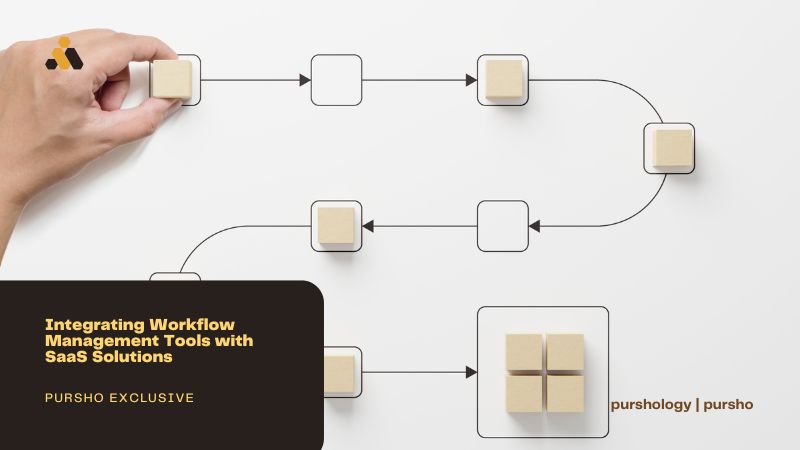In the dynamic landscape of modern businesses, efficiency and productivity are paramount. Streamlining processes and workflows has become a cornerstone of success, prompting the widespread adoption of workflow management tools.
These tools empower organisations to organise, automate, and optimise their tasks, ensuring smooth operations and better utilisation of resources.
Concurrently, Software as a Service (SaaS) solutions have emerged as a pivotal component of the digital ecosystem, offering scalable and accessible software delivery over the internet.
Recognizing the potential synergy between workflow management tools and SaaS solutions, businesses are increasingly integrating the two to enhance their operational prowess.
Understanding Workflow Management Tools:
Workflow management tools encompass a diverse array of software designed to facilitate the orchestration and execution of tasks within an organisation. These tools typically offer features such as task assignment, progress tracking, collaboration functionalities, and automation capabilities.
By providing a centralized platform for managing workflows, they enable teams to coordinate activities more effectively, minimize errors, and expedite project completion.
Popular examples of workflow management tools include Trello, Asana, Monday.com, and Jira.
The Rise of SaaS Solutions:
SaaS solutions have revolutionised the software industry by offering convenient and cost-effective alternatives to traditional on-premises software deployment.
Through the SaaS model, users can access applications via the internet on a subscription basis, eliminating the need for extensive infrastructure investments and maintenance overheads.
SaaS solutions span a broad spectrum of applications, including customer relationship management (CRM), enterprise resource planning (ERP), human resource management (HRM), and more.
Notable SaaS providers include Salesforce, Microsoft 365, Google Workspace, and Zendesk.
Integration Benefits:
Integrating workflow management tools with SaaS solutions yields several compelling benefits for organisations:
-
Seamless Collaboration:
- By bridging workflow management tools with SaaS platforms, teams can seamlessly collaborate on projects without switching between multiple applications.
- This integration ensures that relevant data and communications are consolidated within a unified environment, fostering greater transparency and cohesion.
-
Automated Workflows:
- Leveraging the automation capabilities of workflow management tools in conjunction with SaaS solutions allows organisations to streamline repetitive tasks and workflows.
- For instance, integration with CRM software can automate lead generation, follow-ups, and customer communications, enhancing sales efficiency and effectiveness.
-
Enhanced Data Accessibility:
- Integrating workflow management tools with SaaS solutions facilitates the exchange of data between different systems, ensuring that information is readily accessible where and when it’s needed.
- This interoperability eliminates silos and empowers stakeholders to make informed decisions based on real-time insights.
-
Scalability and Flexibility:
- SaaS solutions are renowned for their scalability, allowing businesses to adjust their software usage according to evolving needs.
- By integrating scalable workflow management tools with SaaS platforms, organisations can effortlessly accommodate growth and adapt to changing operational requirements without significant infrastructure investments.
-
Improved Productivity and Efficiency:
- The combined power of workflow management tools and SaaS solutions enables organisations to optimise their processes, reduce manual intervention, and expedite task completion.
- This heightened efficiency translates into increased productivity, cost savings, and competitive advantage in the marketplace.
Implementation Considerations:
While the benefits of integrating workflow management tools with SaaS solutions are undeniable, successful implementation requires careful planning and consideration of several factors:
-
Compatibility:
- Ensure that the chosen workflow management tool and SaaS solution are compatible and offer robust integration capabilities.
- Evaluate factors such as APIs, data synchronisation mechanisms, and supported functionalities to determine the feasibility of integration.
-
Security and Compliance:
- Prioritise data security and compliance when integrating workflow management tools with SaaS solutions.
- Implement encryption, access controls, and authentication mechanisms to safeguard sensitive information and adhere to relevant regulatory requirements.
-
User Training and Adoption:
- Invest in comprehensive user training to familiarise employees with the integrated platform and maximise adoption rates.
- Encourage ongoing education and provide adequate support to address any challenges or concerns during the transition period.
-
Customization and Configuration:
- Tailor the integration to suit the specific needs and workflows of your organisation.
- Leverage customization options and configuration settings to optimise the user experience and align the integrated platform with your business objectives.
-
Monitoring and Optimization:
- Continuously monitor the performance of the integrated solution and gather feedback from users to identify areas for improvement.
- Fine-tune workflows, settings, and integrations based on analytics data and user insights to ensure optimal efficiency and effectiveness over time.
Conclusion:
Integrating workflow management tools with SaaS solutions offers a potent strategy for enhancing organisational efficiency, collaboration, and agility in today’s fast-paced business environment.
By harnessing the complementary strengths of these technologies, organisations can streamline processes, automate workflows, and unlock new levels of productivity and innovation.
However, successful integration requires careful planning, diligent execution, and ongoing optimization to realise its full potential.
Embrace the transformative power of integration and empower your organisation to thrive in the digital era.




